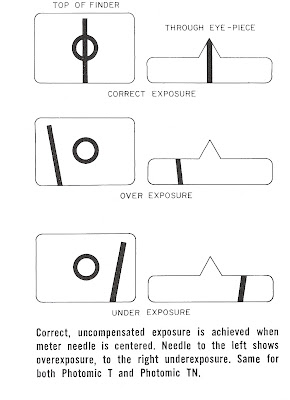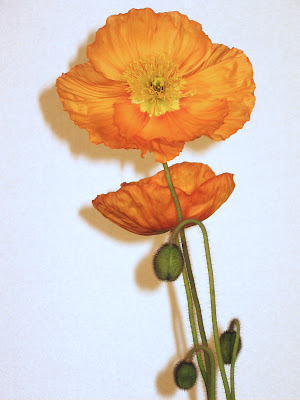In camera light meters.It should be stated here that the type of cameras I will be discussing are pretty much all made 30-40 years ago when cameras were for the most part entirely mechanical with no need for a battery except to power a CdS light meter. I have posted here an illustration from the Nikon Handbook giving examples of the typical indicator in a camera lightmeter that informs you when you have the proper exposure for the film you are using.
For those not versed in analog photography in the pre-auto- indexed, auto-focus era it helps to understand two factors in film exposure. One is Apeture controlled by a camera
diaphragm which relates to the
volume of light coming through the lens. It is measured by a series of f stops each one being twice as large as the one preceding it. The largest apeture opening has the smallest number and they go something like this; f1.4, 2, 2.8, 3.5, 4, 5.6, 8, 11, 16, 22, 32, 45. f1.4 lets in twice as much light as f2, f2 twice as much light as f2.8 and so on. The second factor in exposure is shutter speed which regulates the
duration of exposure and again each number is twice as fast as the one before it and they go something like this on most cameras going from slowest to fastest, 1 second, 1/2 (of a ) second, 1/4, 1/8, 1/15, 1/30, 1/60, 1/125, 1/250, 1/500, 1/1000, 1/2000. So if you were to make an exposure of 1/125 of a second at f16, you could make the exact same exposure with 1/250 of a second at f11 or 1/60th of a second at f22. Exact same exposure but not exact picture since each change in shutter speed and apeture will have an impact on the image.
You know a light meter is functioning if it correctly demonstrates this factor. If you were to look through a camera to see if its light meter was functioning properly manipulate the apeture and shutter speed until the needle is centered and then change the apeture to one stop larger or smaller you would have to also make a comparable change in the shutter speed to return the needle to center. Using the example above if you were able to center the meter at a shutter speed of 1/125th of a second at apeture setting f16 if you doubled the exposure by slowing the shutter speed to 1/60th you would have to halve the the volume of light by changing the apeture setting to f22. Set the shutter speed twice as fast to 1/250th of a second you would have to double the volume of light by changing the apeture setting to f11.
Knowing this rule we can test a light meter if it works and is there for functional if it can pass this test. The needle should move smoothly and stay in place when we have settled on one setting of apeture and exposure. It may not be giving us an accurate exposure but at least we know the meter is working and can be calibrated to give an accurate exposure.

















































